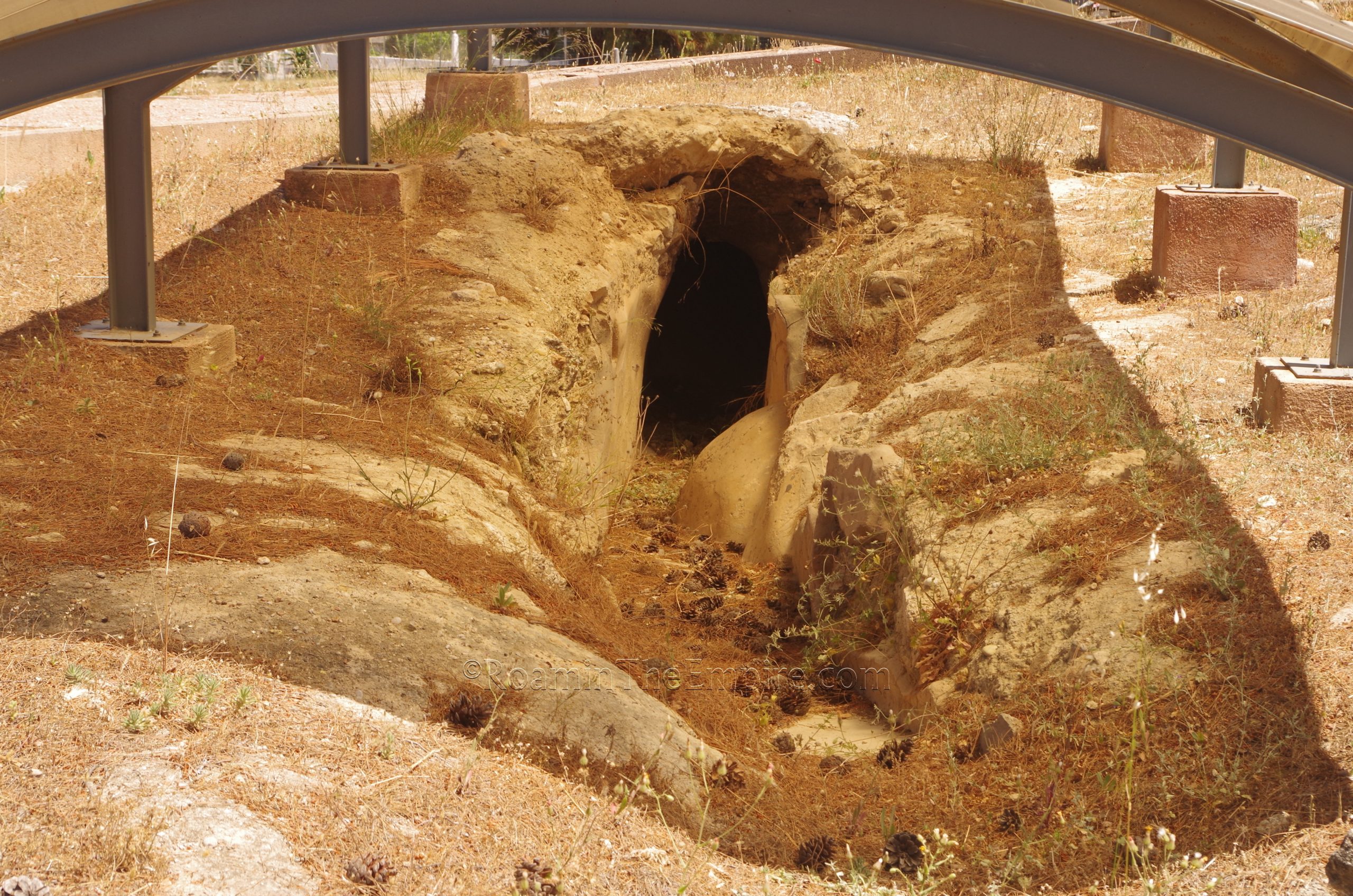
Most Recent Visit: May 2021
Near the narrowest part of the Corinthian Isthmus, less than a kilometer from the eventual site of the Corinthian Canal, the site known today as Isthmia began life as a localized sanctuary site. The name Isthmia is a modern description of the specific site, as the entire area of the isthmus would have been referred to by that description. Legendarily, the foundation of the sanctuary dates back to the death of Melikertes. Melikertes was the son of Ino, who after her husband Athamas was driven mad by Hera (in revenge for Ino raising Dionysus) and killed their other son Learchus, she cast herself and Melikertes into the Saronic Gulf in an attempt to escape. Ino was changed into the sea goddess Leucothea, while Melikertes became Palaemon, who drown in the gulf. He was carried back to the Corinthian Isthmus where he was laid under a pine tree until the discovery of his body by his uncle Sisyphus, legendary king and founder of Corinth. Melikertes/Palaemon was buried on the isthmus, and the funerary games for him would become the basis for the Isthmian Games held at the site.
Though the funerary origin was with Melikertes/Palaemon, they would be dedicated to Poseidon, whose sanctuary formed the nucleus of the sanctuary where the games were held. The Athenians contended the games were founded by their legendary founder king, Theseus, who expanded the funerary games, opened them to all Greeks, and dedicated the expanded Isthmian Games to Poseidon. The games were held in the spring of the 2nd and 4th years of the Olympiad and were instituted as Panhellenic games in the 49th Olympiad, making 582 BCE the first year they were held as Panhellenic games. Though the Isthmian Games were open to all Greeks as of that year, Corinth retained administration of the games.
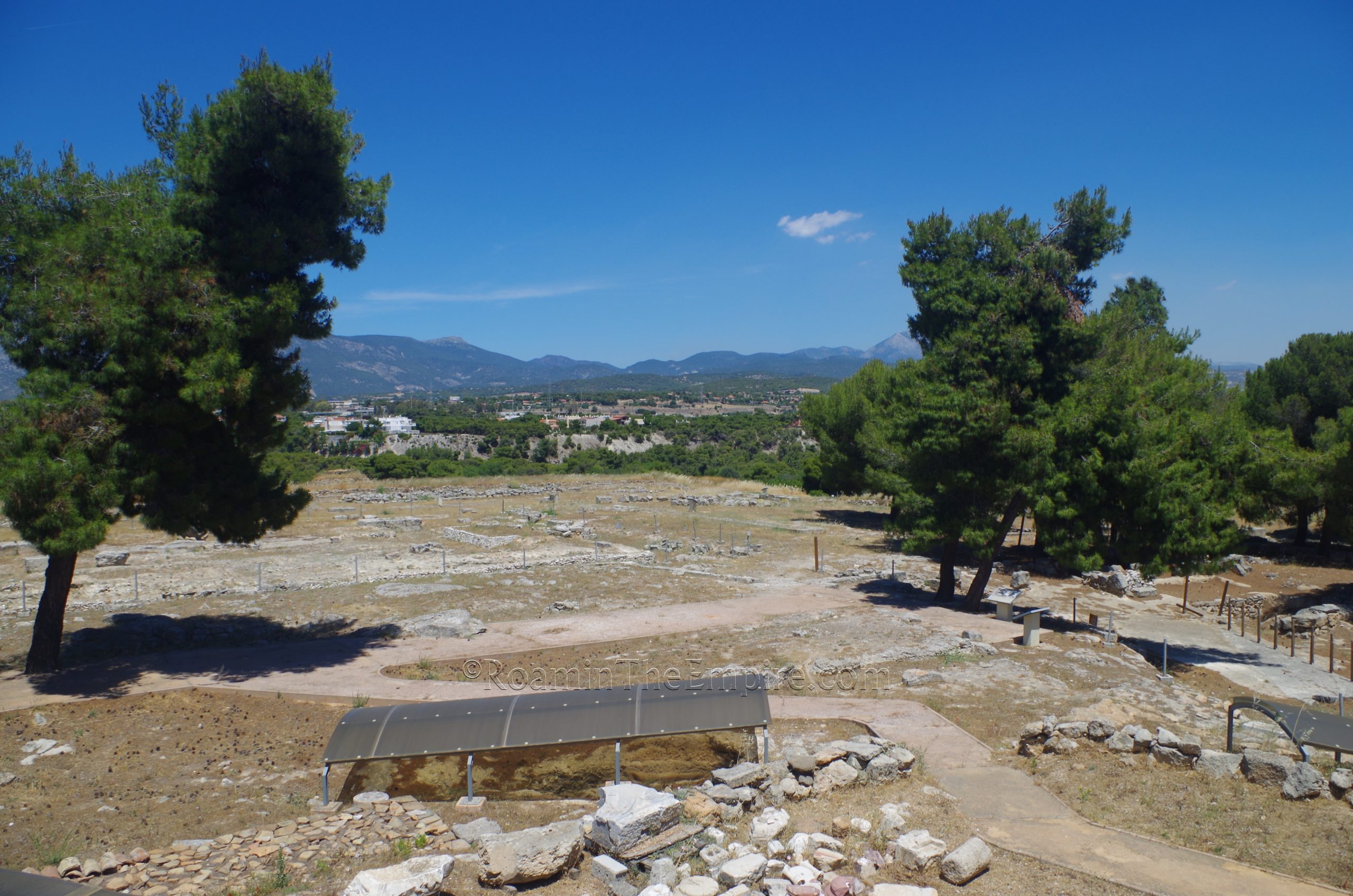
Like the other Panhellenic games, the Isthmian Games were open to all Greeks regardless of the current state of political affairs. The location of the Isthmian sanctuary on the bridge between the Peloponnese and the rest of Greece made it an attractive location for meetings and conferences among the Greeks. In 481 BCE, it was the site of a conference among Greek city-states where it was agreed to suspend internal conflict in order to best meet the incoming Persian threat. Starting about 228 BCE, the Romans were allowed to participate in the Isthmian games.
The sanctuary was heavily damaged during the Roman siege of Corinth during the Second Macedonian war in 198 BCE. Just a few years later, after the Romans had defeated the Macedonians, Isthmia was chosen as the location at which Titus Quinctius Flaminius would deliver a rousing speech during the games of that year, proclaiming the freedom of the Greeks and the end of Macedonian hegemony in Greece. With the destruction of Corinth by the Romans in 146 BCE, the administration of the Isthmian games was moved to Sicyon, and it seems as though the games were held there, rather than at the Isthmia sanctuary, though the latter point is not entirely clear. It is believed that the sanctuary suffered additional damage and perhaps looting at this time.
When Corinth was re-founded in 44 BCE, the administration of the games returned to Corinth, but again, the games were now held in Corinth rather than at the Isthmian sanctuary. The Isthmian games were finally restored to the Isthmian sanctuary about 43 CE, following repairs and rebuilding of the facilities that had likely been left in disrepair for many years. Nero competed in, and won, a singing competition at the Isthmian games of 66 CE, moved up from 67 CE to accommodate the emperor’s participation. He also used the occasion to proclaim the freedom of the Greeks and their exemption from taxes in the stadium at Isthmia, clearly seeking to emulate the proclamation of Titus Quinctius Flaminius. The games likely continued into the 4th century CE, but the sanctuary seems to have fallen into disrepair and abandonment following Constantine’s banning of pagan worship.
Getting There: Like some of the other outlying sites in the vicinity of Corinth, Isthmia is theoretically reachable by bus, but it’s kind of difficult to decipher the available information in advance. As such, a personal vehicle is probably the most reliable way to visit. It is about 10 minutes from ancient or modern Corinth, and the remains are all centered in the museum/archaeological park complex or just outside of it.
The Isthmia archaeological park and museum don’t seem to have an actual address, just generally Kyra-Vrysi Isthmia. There are lots of signs to point you in the direction, and of course, it is pinned on the map. From June through the end of October, the museum is open Tuesday to Sunday from 9:00 to 16:00. The rest of the year, it is open from 8:00 to 15:00. Admission is 3 Euro for the museum and archaeological park.
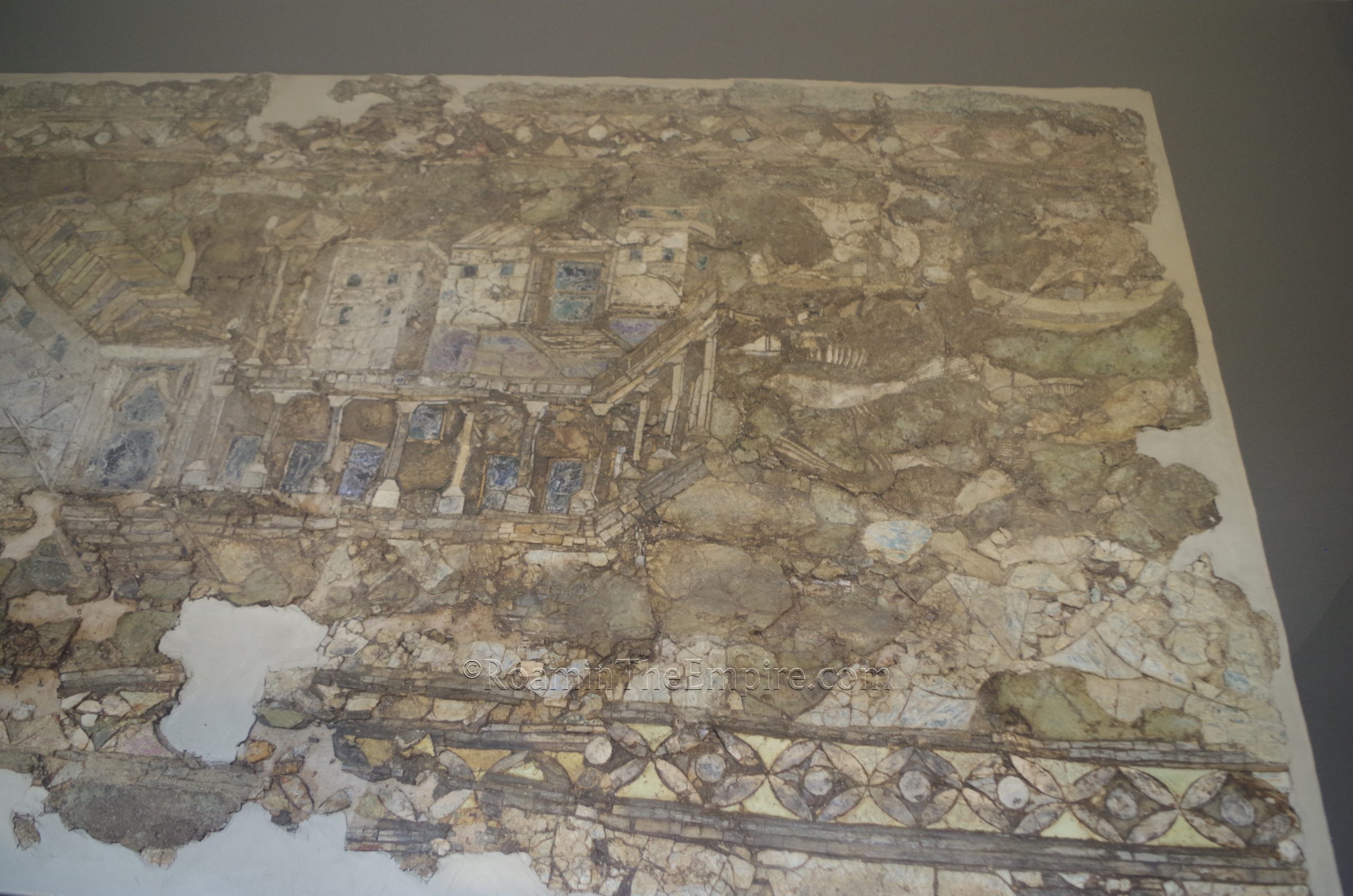
Since entry is through the museum, the museum is the logical place to start. As one would expect, there are a number of artifacts associated with the Isthmian games; inscribed jumping weights, an iron discus, the iron spokes of a chariot. There’s also some stele noting the victories of athletes in the games. Various elements from different phases of the Temple of Poseidon are also housed here. Perhaps the most spectacular pieces in the museum are from nearby Cenchreae, though. A number of opus sectile glass panels were found there and are now in the museum. Some of them are just geometric designs, but other depict actual figural scenes. There’s also some wooden objects from Cenchreae as well, including a nearly fully intact wood door.
There are also some sculptural fragments as well as the inscribed column, though to be a dedication to Isis. Also from Cenchreae. Also interesting are some stone catapult missiles from the nearby Rachi settlement, probably dating to the Roman siege at Corinth in 198 BCE. It’s not an especially large museum, the collection is pretty easily seen in a half hour to forty-five minutes. But, there are definitely some nice pieces. Again, the glass panels are not to be missed, and it’s really kind of amazing that they are in this sort of out of the way museum. I had no idea they were there before visiting; it was a very welcome surprise.
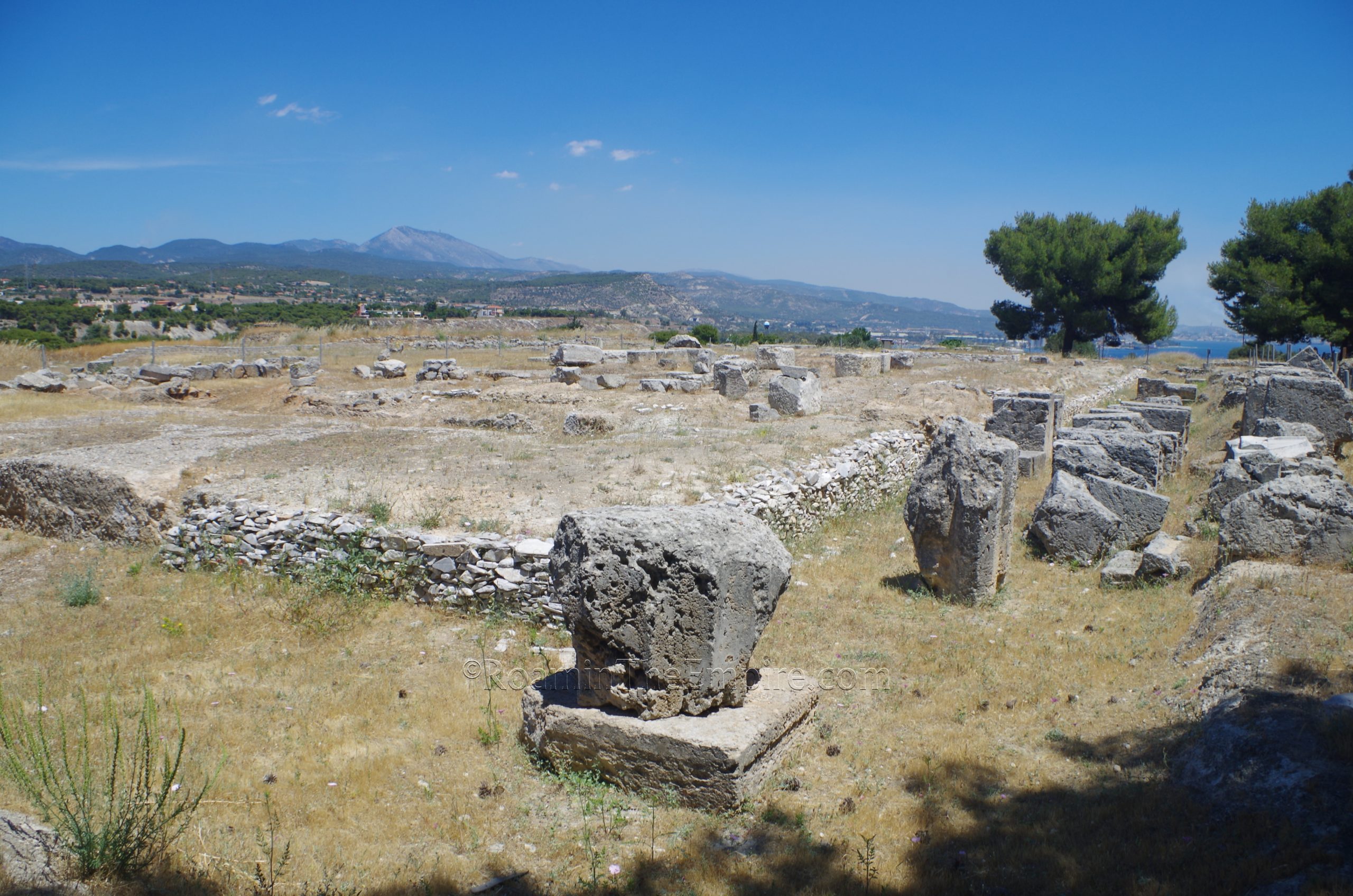
Just outside the museum is a 6th century BCE pit, probably a water storage feature, that was later filled in with debris from the Archaic temple. It is currently obscured by a wooden cover. Beyond that, though, the area of the Temple of Poseidon stood just to the north of the museum. There is evidence of ritual activity at this site dating back to perhaps the 11th century BCE, but it wasn’t until the middle of the 7th century BCE that a temple was constructed here. A fire in the first half of the 5th century BCE destroyed the temple and a new, larger temple was built in its place. Another fire destroyed that temple around 390 BCE, necessitating extensive renovations.
The precinct of the temple was enlarged considerably after the Roman rebuilding of the sanctuary in the 1st century CE. Later, sometime in the mid-2nd century CE, the precinct was further enlarged and porticoes were constructed around all four sides of the temple precinct. The temple remained standing until about the 5th century CE, when it was dismantled to provide material for the construction of the nearby Hexamilion Wall. The foundations of the podium of the temple as well as those of the surrounding portico and temple precinct are visible.
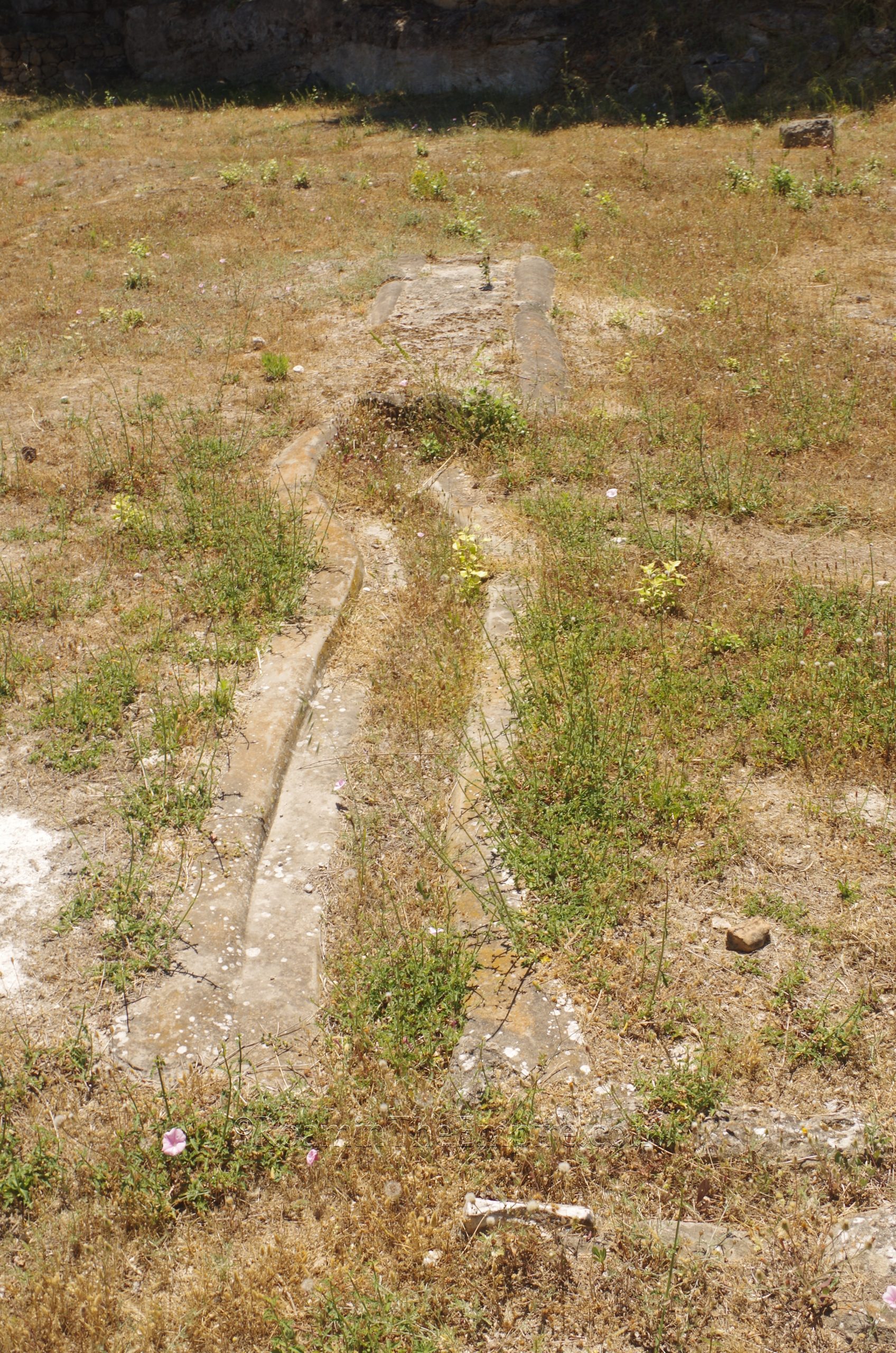
To the west of the temple, within the Roman precinct, is an area known as the west waterworks. Here, a series of channels and a basin can be seen. The original date of construction is unclear, but it seems to predate the destruction of the temple in the 4th century BCE. It then seems to have functioned up until the Roman destruction, at which point these works fell into disuse. At the time, there was also a sunken room here, but only the very bottom part survives as the area was leveled off during the 3rd century CE. The function may have been some sort of area for cleansing associated with the cult of chthonic deities.
To the southeast of the Temple of Poseidon is a cult complex that was dedicated to the hero Palaemon/ Melikertes. This area was previously the location of the nearly 200 meter stadium. Originally constructed in 550 BCE and running along a northwest/southeast axis, the stadium underwent several different forms until it was finally abandoned around the 3rd century BCE. This coincided with the construction of a new stadium to the southeast. Almost no excavation has been done on the first stadium, though some of the elements of the starting gates (and sometimes reconstructions of the starting posts inserted into them) near the southeast corner of the Temple of Poseidon.
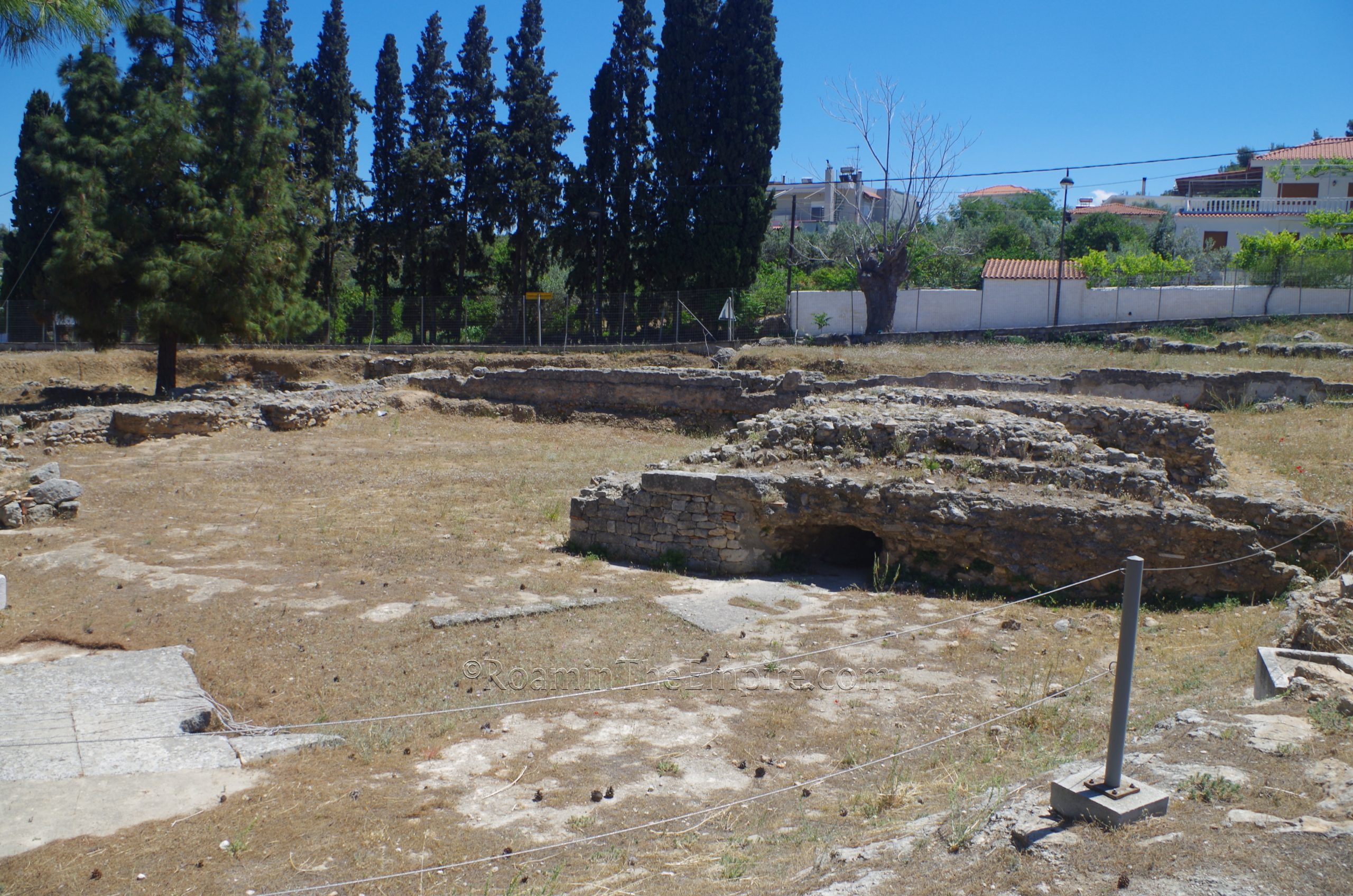
Sometime around the middle of the 1st century CE, the cult space of Palaemon was initially constructed at Isthmia, seemingly at first just consisting of a chamber, seemingly a pre-Roman reservoir, and channel that served as the tomb of the hero. A round temple was built just to the east of the Temple of Poseidon during the reign of Hadrian. Though some foundations of the temple are visible at its original spot, it was deconstructed and moved over near the tomb of Palaemon, where a more robust foundation is visible now, as well as the channels that connected the temple to the tomb. Prior to the Roman rebuilding of the city, a shrine to Palaemon seems to have been located along the shore of the Saronic Gulf.
There’s some excavated structures a bit to the east, they aren’t very easily accessible (a walk through some low brush) or have any signs posted, so they really don’t seem to be a central part of the visit. What’s here apparently are some residential and food preparation structures associated with the sanctuary.
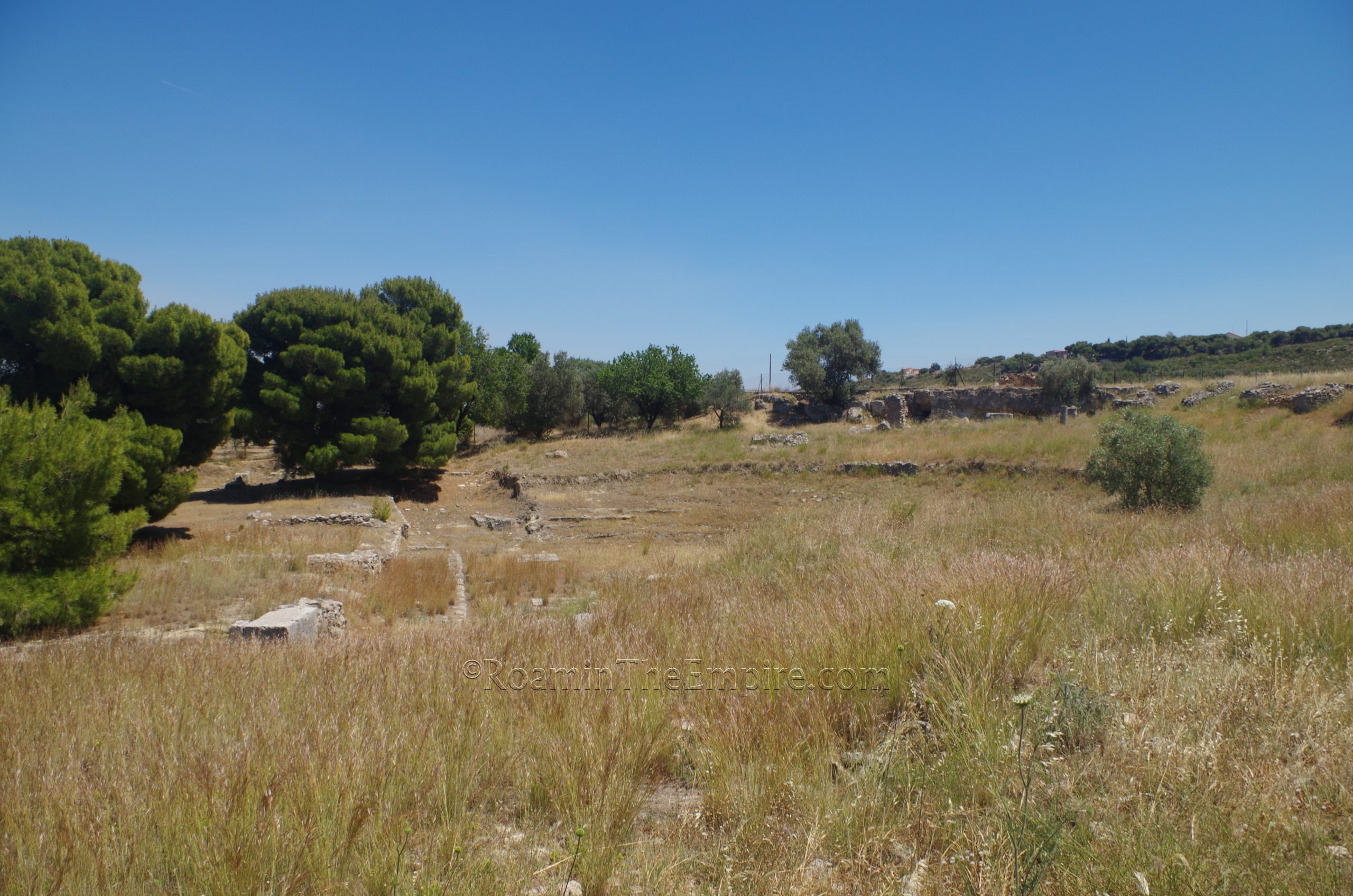
Near the northeast corner of the Temple of Poseidon precinct are a couple of excavated subterranean areas known as the Cult Caves, made up of the Theater Cave and Northeast Cave. There isn’t a whole lot to see here because of the way the excavated parts are restricted, but, apparently these two caves served as ritual dining areas for a cult or cults related to unknown deities. They were originally constructed in the latter half of the 5th century BCE and used for about 100 years before being abandoned.
A little farther northeast is the theater of Isthmia. The original theater seems to have been constructed at the start of the 4th century BCE with a major renovation occurring at the end of the 4th century as well. It was probably renovated a second time during the Greek period. After the return of the Isthmian games and reoccupation by the Romans, the theater was drastically remodeled in a more Roman style, particularly with regard to the expansion of the scenae and cavea to give it the Roman D shape as opposed to the more encompassing C shape and smaller stage of the Greek style. This possibly occurred in the mid-1st century CE in preparation for Nero’s visit. It was again renovated in the 2nd century CE, though only the foundations of the later reconstruction were actually completed. There is no direct access to the theater, it is roped off and only visible from around the exterior from the south and west sides.
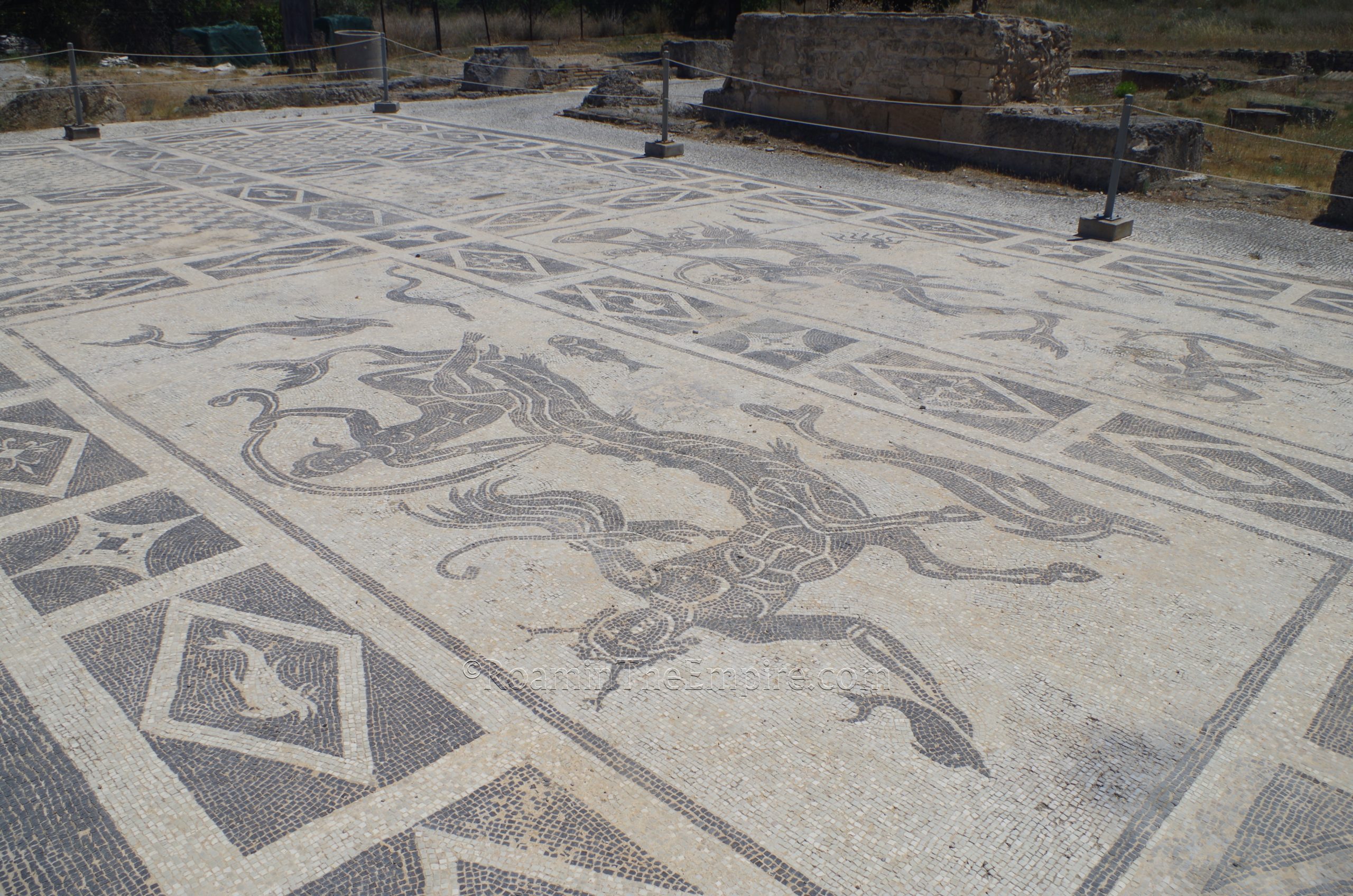
The final site inside the archaeological park is the Roman baths, northwest of the theater. These baths seem to have been constructed in the mid-2nd century CE, probably as part of a complex that served the needs of athletes competing in the Isthmian games. There seems to have been an earlier bathing complex dating to about the mid-4th century BCE that stood on this site previously. Probably with the same function, and seemingly the largest Greek bathing complex known. The remnants of the pool of this complex have been found along the south side of the complex, running through and south of the large apsidal tepidarium of the Roman structure. The Roman baths were destroyed sometime around 400 CE.
The most prominent feature of these baths is the large marine themed mosaic of the reception room, apparently the largest such mosaic found in the Eastern Mediterranean. Though only a path around the outside of the mosaic area is accessible, this does allow views into many of the rooms directly linked to the reception area, including, again, the apsidal tepidarium with a great many pilae of the hypocaust system conserved/reconstructed on the south side. Some of the hypocaust system of the caldarium is also visible at the southwest corner of the reception room. The frigidarium on the northwest corner can be entered and the pool on the west side of the room is visible. The mosaicked apodyterium on the southeast side of the reception area as well.
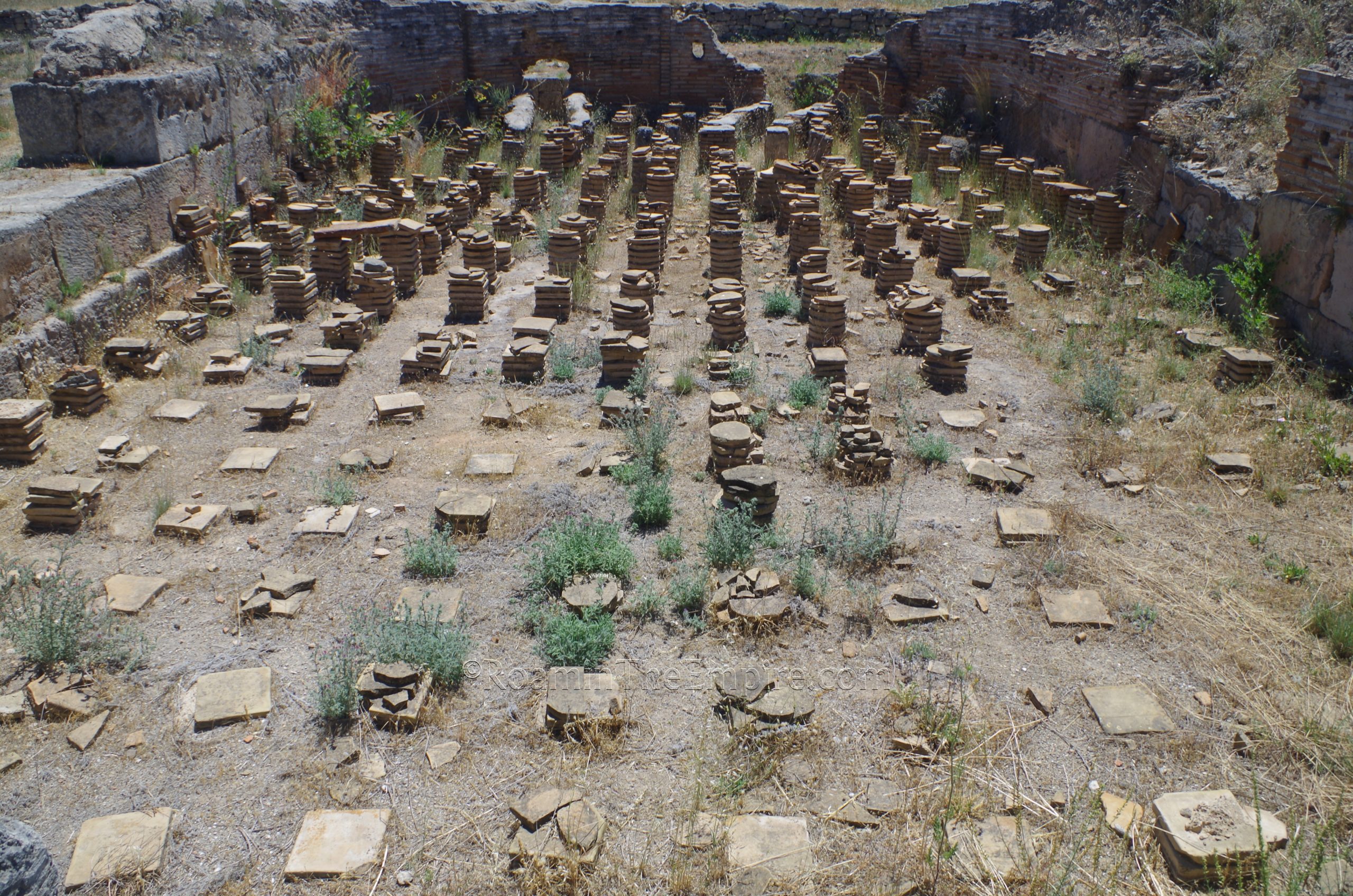
There are a few visible remains outside the archaeological park. Heading east along the road just in front of the museum, about 225 meters along, the road curves to the northeast and some fairly significant elements of the sanctuary’s fortification wall can be seen on the north side of the road. These stretch for about 120 meters, parallel to the road, before curving to the northeast, where they are less visible from the area alongside the road. The area of the second stadium is also visible just to the south of the road here. There seem to be a few stone elements visible, but, the actual shape of the stadium is hard to see from this vantage point, and getting a better look would require tromping through some brush. The outline of the stadium is pretty clearly visible on satellite photos, though.
The Isthmia museum and site together took me a little over an hour, with a few minutes thrown in to see the things outside of the park. It’s not a tremendously big museum or site, but quite interesting and certainly worth the stop. Much of the archaeological area is roped off and most monuments can only be viewed from a delineated visitor’s path. The museum alone is worth the price of admission for the glass panels.
Sources:
Broneer, Oscar. “Excavations at Isthmia: Fourth Campaign, 1957-1958”. Hesperia: The Journal of the American School of Classical Studies at Athens, Vol. 28, No. 4, October-December 1959, pp. 298-343.
Gebhard, Elizabeth, R. “The Isthmian Games and the Sanctuary of Poseidon in the Early Empire.” Journal of Roman Archaeology, Supplemental Series Number 8, 1991.
Gebhard, Elizabeth R. and Timothy E. Gregory (eds.). Bridge of the Untiring Sea: The Corinthian Isthmus from Prehistory to Late Antiquity. Princeton: American School of Classical Studies, 2015.
Pausanias. Hellados Periegesis, 2.2.
Stillwell, Richard, William L. MacDonald, and Marian Holland. McAllister. The Princeton Encyclopedia of Classical Sites. Princeton, NJ: Princeton U Press, 1976.
Suetonius. The Life of Nero, 24.


